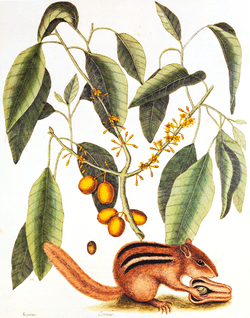Mark Catesby

Mark Catesby (24 March 1682/83 – 23 December 1749) was an English naturalist. Between 1729 and 1747 Catesby published his Natural History of Carolina, Florida and the Bahama Islands, the first published account of the flora and fauna of North America. It included 220 plates of birds, reptiles and amphibians, fish, insects, and mammals, as well as plants.
Life and works
Catesby was born on 24 March 1682/83 and baptized at Castle Hedingham, Essex on 30 March 1683. His father, John Catesby (buried 12 November 1703), was a lawyer and gentleman farmer. His mother was Elizabeth Jekyll (buried 5 September 1708). The family owned a farm and house, Holgate, in Sudbury, Suffolk. An acquaintance with the naturalist John Ray led to Catesby becoming interested in natural history. He studied natural history in London before going to stay with his sister, Elizabeth Catesby Cocke, in Williamsburg, Virginia in 1712. The death of his father, nine years earlier, had left Catesby enough to live on. Elizabeth was the wife of Dr. William Cocke, who had been a member of the Council and Secretary of State for the Colony of Virginia. According to family lore, Elizabeth married Dr. Cocke, against the wishes of her parents, before emigrating to Virginia.[1] After his stay in Williamsburg, Catesby visited the West Indies in 1714, and returned to Virginia, then home to England in 1719.

Catesby had collected seeds and botanical specimens in Virginia, which he had sent to a Hoxton nurseryman Thomas Fairchild. This made his name known to other scientists in England, and in 1722 he was recommended by William Sherard to undertake a plant-collecting expedition to Carolina on behalf of the Royal Society. Catesby settled in Charlestown, and traveled to other parts of eastern North America and the West Indies, collecting plants and animals. Many of these specimens were sent to Hans Sloane in London at the Chelsea Physic Garden, and to William Sherard. Catesby returned to England in 1726.

Catesby spent the next seventeen years preparing his Natural History. Publication was financed by an interest-free loan from one of the fellows of the Royal Society, the Quaker Peter Collinson. Catesby was the first to use folio-sized coloured plates in natural history books. He learnt how to etch the plates himself. The first eight plates had no backgrounds, but from then on Catesby included plants with his animals. He completed the first volume in 1731, and in February 1733 he was elected a fellow of the Royal Society. The second volume was completed in 1743, and in 1746–1747 he produced a supplement from material sent to him by friends in America, particularly John Bartram. Catesby's original preparatory drawings for Natural History of Carolina, Florida and the Bahama Islands are in the Royal Library, Windsor Castle, and a selection was exhibited in USA, Japan and at the Queen's Gallery, London, in 1997–1998. On 5 March 1747, Catesby read a paper entitled "Of birds of passage" to the Royal Society in London, and he is now recognised as one of the first people to describe bird migration. Mark Catesby married Elizabeth Rowland on 2 October 1747. He died just before Christmas 1749 on Saturday 23 December in his house behind St Luke's Church, Old Street, London. Catesby's Hortus britanno-americanus ... was published posthumously in 1763, and a second edition, entitled Hortus Europae americanus ... was issued in 1767.
Carolus Linnaeus included much of the information from Catesby's Natural History in Linnaeus's 10th edition of Systema Naturae (1758).
Catesbaea, lilythorn, a genus of thorny shrubs belonging to Rubiaceae (madder family) from the West Indies and southeastern USA was named after Catesby by Linnaeus in 1753 in his Species plantarum (volume 1, pp 108–109), based on plate 100 in volume two of Catesby's Natural history of Carolina, Florida and the Bahama Islands.
Gallery of Catesby's images
 Lachnolaimus maximus, 1725
Lachnolaimus maximus, 1725 Anguinis viridis, 1743
Anguinis viridis, 1743 Lophodytes cucullatus, 1748
Lophodytes cucullatus, 1748 Ventro Rubro, Melanerpes carolinus, 1749
Ventro Rubro, Melanerpes carolinus, 1749 Turdus minimus (now Catharus minimus) and dahoon holly (Ilex cassine), 1754
Turdus minimus (now Catharus minimus) and dahoon holly (Ilex cassine), 1754 Rana Aquatica, The Water-Frog, 1754
Rana Aquatica, The Water-Frog, 1754 Cance Chelis Rubis, The red-claw Crab; Titanokeratophyton &c., 1754
Cance Chelis Rubis, The red-claw Crab; Titanokeratophyton &c., 1754
 Coccothraustes rubra (probably Cardinalis cardinalis) and Nux Juglans alba Virginiensis, 1754
Coccothraustes rubra (probably Cardinalis cardinalis) and Nux Juglans alba Virginiensis, 1754 Ardea herodias, 1771
Ardea herodias, 1771
See also
References
- ↑ Rowe, Linda H. "William Cocke (1672–1720)". Encyclopedia Virginia. Retrieved 29 June 2015.
| Wikimedia Commons has media related to Mark Catesby. |
| Wikisource has the text of a 1900 Appletons' Cyclopædia of American Biography article about Mark Catesby. |
- Jackson, Christine E., (1985) Bird Etchings: the illustrators and their books, 1655-1855. Ithaca: Cornell University Press ISBN 0-8014-9684-5
- Walters, Michael (2003) A Concise History of Ornithology. London: Christopher Helm ISBN 1-873403-97-6
- Wiatt, Alex L. (1992) The Descendants of Stephen Field of King and Queen County, Virginia, 1721, Fredericksburg VA: BookCrafters
- Myers, Amy R. W. & Pritchard, M. B. (1998) "Empire's nature. Mark Catesby's New World vision," Chapel Hill & London: University of North Carolina Press ISBN 0-8078-4762-3
External links
Works
- Mark Catesby (1731). The Natural History of Carolina, Florida and (v1). Online scanned edition from Rare Book Room.
- Mark Catesby (1743). The Natural History of Carolina, Florida and (v2). Online scanned edition from Rare Book Room.
- Mark Catesby, The Natural History of Carolina, Florida and the Bahamas Electronic edition: high quality images and user-friendly text from the American Studies Programs at the University of Virginia
- View works by Mark Catesby online at the Biodiversity Heritage Library.